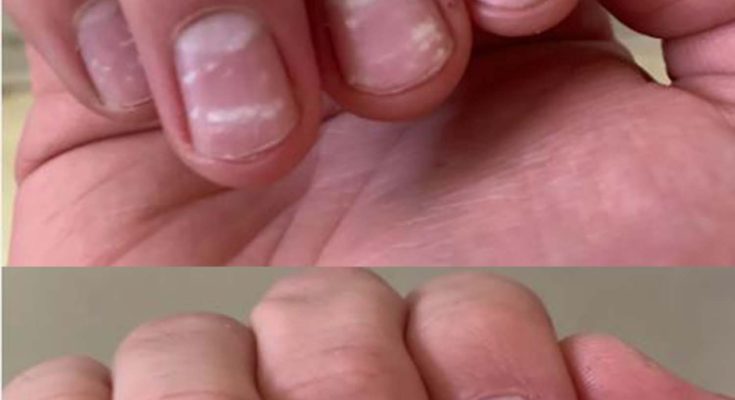Leukonychia refers to the white discoloration of nails that occurs in several conditions. The normal nail is pale pink with a whitish crescent called the lunula at the base. It is the most common color variation in the nails. Other names for this condition are white nails, fortune spots and gift spots. The word comes from the Greek “leuko” which means white, and “onyx” which means nail.

The white discoloration comes from light reflected off sizable particles of keratohyaline material, which accumulate in the parakeratotic cell layer in the ventral part of the nail plate. This obscures the pink color that is normally apparent because of the normal vascular bed in the nail base.
While the whole nail may be involved in some conditions, punctate leukonychia is manifested as white spots or flecks on the nails. Leukonychia may be complete or partial. Some types are hereditary, while other patients develop leukonychia as the result of systemic disease.
Common causes of Leukonychia
Acquired Punctate and Striate Leukonychia
Mees lines
These are present in arsenic poisoning. There are single or multiple white lines running across the nail, parallel to the lunula. More than one nail may be involved. The lines persist on blanching. They move forward across the nail as it grows. The nail plate is microscopically fragmented, and parakeratotic cells are present. The disruption of nail growth causes the white lines. The distance of the lines from the cuticle at the proximal nail fold shows how long ago the illness or poisoning occurred.
Other conditions which present with Mees lines include Hodgkin’s disease, leprosy and tuberculosis, chemotherapy, herpes zoster, renal and cardiac failure, and pneumonia.
Muehrcke’s lines
These are specific transient double white lines which appear in hypoalbuminemia, when the albumin level dips below 2 g/dL. These disappear when the nail is blanched by pressure. The lines also do not move forward with time. The phenomenon is confined to the nail bed, and is supposed to be the result of edema under the nail plate, putting pressure on the nail bed at localized points. Interestingly, they vanish once the protein level returns to normal. Conditions which cause Muehrcke’s lines include nephrotic syndrome, glomerulonephritis, liver disease, malnutrition, and chemotherapy.
Half-and-half nails, or Lindsay’s nails
The nails are white proximally but brown distally, and are specific to chronic renal failure with uremia.
Terry’s nails
In this condition, the nails are white towards the base, but normally colored distally. They are seen in diabetes mellitus diagnosed in adult life, congestive cardiac failure, peripheral vascular disease, HIV, and in hemodialysis patients.
In many adults and children, random white lines or specks appear on one or more nails. These are non-significant and are thought to be the result of minor injuries to the nail bed, which are not even remembered.
Total Congenital Hereditary Leukonychia
This condition presents with a marble-white appearance of all the nails, and is usually inherited in an autosomal dominant pattern. It involves the whole nail plate. The defect is one of the PLCD1 gene on chromosome 3, which encodes for the color and growth of the nail plate.
Acquired Total Leukonychia
In conditions such as diabetes, renal, and cardiac failure, renal stones, and Hodgkin’s disease, total white discoloration of the nails may occur.
Management
Leukonychia is treated by looking for and identifying any underlying systemic illness.
